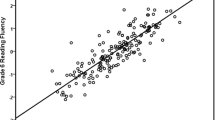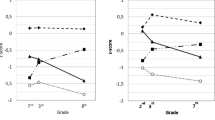Abstract
The reading levels and reading strategies of 43 children with genetic dyslexia, right-hemisphere lesions/dysfunction, and left-hemisphere lesions/dysfunction were retrospectively compared. Age and IQ were comparable. Only children who had a verbal or performance IQ over 90 were included in the study. Although the genetic dyslexics had a significantly higher Full Scale IQ than the other two groups, their reading level was significantly lower. This suggests that a disturbance of the normal processes of neuronal migration during fetal development may have profound effects on specific cognitive processes, without affecting others. In contrast, 50 percent of the boys with left-hemisphere deficits were disabled readers. One-third of the boys with right-hemisphere deficits were also poor readers. With one exception, the girls, who had comparable deficits, were good readers. A comparison was made between the groups in terms of reading strategies and patterns of errors.
Similar content being viewed by others
References
Benton, A. L. 1984. Dyslexia and spatial thinking.Annals of Dyslexia 34:69–86.
Boder, E. 1973. Developmental dyslexia: A diagnostic approach based on three atypical reading-spelling patterns.Developmental Medicine and Child Neurology 15:663–687.
Denckla, M. B. Minimal brain dysfunction and dyslexia: Beyond diagnosis by exclusion. 1977.In M. E. Blaw, I. Rapin, M. Kinsbourne (eds.).Topics in Child Neurology. New York: Spectrum Publications.
Finucci, J. M., and Childs, B. M. 1981. Are there really more dyslexic boys than girls?In A. Ansara, N. Geschwind, and A. Galaburda (eds.).Sex Differences in Dyslexia. Towson, Md: The Orton Dyslexia Society.
Finucci, J. M., Issacs, S. D., Whitehouse, C. C., and Childs, B. 1982. Empirical validation of reading and spelling quotients.Developmental Medicine and Child Neurology 24:733–744.
Galaburda, A. M., Sherman, G. F., Rosen, B. D., Aboitiz, F., and Geschwind, N. 1985. Developmental dyslexia: Four consecutive patients with cortical anomalies.Annals of Neurology 18:222–234.
Geschwind, N. and Behan, P. 1982. Left-handedness: Association with immune disease, migraine and developmental learning disorder.Proceedings National Academy of Science, USA 79:5097–5100.
Glass, G. V. and Hopkins, K. D. 1984.Statistical Methods in Education and Psychology. Englewood Cliffs, N.J.: Prentice-Hall.
Gordon, H. W. 1980. Cognitive asymmetry in dyslexic families.Neuropsychologia 18:645–656.
Gray, W. S. 1967.Gray Oral Reading Tests. Indianapolis: Bobbs: Merrill.
Hinshelwood, J. 1895. Word blindness and visual memory.Lancet I:1564–1570.
Ingram, T. T. S., Mason, A. W., and Blackburn, I. 1970. A retrospective study of 82 children with reading disability.Developmental Medicine and Child Neurology 11:272–281.
Jastak, J. F., and Jastak, S. R. 1978. The Wide Range Achievement Test Manual. Wilmington, Delaware: Guidance Associates.
Liberman, I. Y., Shankweiler, D., Orlando, C., Harris, K. S., and Berti, F. B. 1971. Letter confusion and reversals of sequence in the beginning reader: Implications for Orton’s theory of developmental dyslexia.Cortex 7:127–142.
Mattis, S., French, J. H., and Rapin, I. 1975. Dyslexia in children and young adults: Three independent neuropsychological syndromes.Developmental Medicine and Child Neurology 17:150–163.
Morgan, W. P. 1896. A case of congenital word-blindness.Speech 23:357–377.
Rutter, M. 1978. Prevalence and types of dyslexia.In A. L. Benton and D. Pearl (eds.).Dyslexia: An appraisal of current knowledge. New York: Oxford University Press.
Rutter, M. and Yule, W. 1975. The concept of specific reading retardation.Journal of Child Psychiatry 16:181–197.
Woodcock, R. W. 1973.Woodcock Reading Mastery Test. Circle Pines, MN: American Guidance Service.
Author information
Authors and Affiliations
Rights and permissions
About this article
Cite this article
Voeller, K.K.S., Armus, J. A comparison of reading strategies in genetic dyslexics and children with right and left brain deficits. Annals of Dyslexia 36, 270–286 (1986). https://doi.org/10.1007/BF02648034
Issue Date:
DOI: https://doi.org/10.1007/BF02648034




